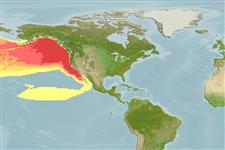Common names from other countries
Environment: milieu / climate zone / depth range / distribution range
Écologie
; profondeur 0 - 1580 m (Ref. 1394). Subtropical; 90°N - 10°N, 180°W - 180°E
Distribution
Pays | Zones FAO | Écosystèmes | Occurrences | Introductions
Eastern Pacific.
Length at first maturity / Taille / Poids / Âge
Maturity: Lm ? range ? - ? cm Max length : 500 cm TL mâle / non sexé; (Ref. 1394); 300 cm TL (female); poids max. publié: 2.2 t (Ref. 1394); poids max. publié: 2.2 t
Feeds on squids, small sharks, and deep water fishes (Ref. 1394).
Jefferson, T.A., S. Leatherwood and M.A. Webber. 1993. (Ref. 1394)
Statut dans la liste rouge de l'IUCN (Ref. 130435: Version 2024-1)
statut CITES (Ref. 108899)
Not Evaluated
Not Evaluated
Utilisations par l'homme
Pêcheries: commercial
FAO - pêcheries: species profile | FishSource | Sea Around Us
Outils
Sources Internet
Estimates based on models
Preferred temperature
(Ref.
115969): 1.5 - 5.3, mean 1.6 (based on 670 cells).
Vulnérabilité
Very high vulnerability (77 of 100).
Catégorie de prix
Unknown.
